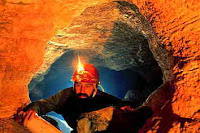Movile Cave, located in Romania, near the Black Sea coast is probably one of the caves that have received the most attention during the last years, both from the mass media and from the scientific community.
What is the reason for such a high interest from such a diverse audience?
... it is a peculiar, practically unique environment, until now the only cave ecosystem completely driven by chemosynthesis (chemosynthesis = production of organic molecules using chemical energy rather than light)...
... it is an extremely small and fragile environment which deserves our protection
... it is one of the richest cave ecosystems regarding the number of species
... more than 30 new species for science were described from this cave,and all are endemic (i.e, they live only in this ecosystem)...
... it can serve as a valuable model for understanding how life can thrive even in the absence of light and under extreme conditions
... the history of its discovery and research is one of committment and dedication
While excavating for a major construction project in 1986, engineers happened to find a cave in which extraordinary conditions prevail. Named the Movile cave, it is the site of a hitherto unknown groundwater ecosystem that is rich in hydrogen sulfide (8-12 mg/l) and in contact with an atmosphere poor in oxygen (7-10%), rich in carbon dioxide (2-3.5%), and also containing significant amounts of methane (1-2%). Its exploration began in 1990.
Until research teams began exploring Movile Cave, its 12000 square meters were entirely sealed off. The cave had no natural entrance and was discovered by accident during some geological research in the area.
The radioactive isotopes common in Romanian soil since the 1986 Chernobyl accident were absent from the cave's sediment. The cave's water had a different chemical makeup than aboveground wells nearby.
Wednesday, September 26, 2007
The Movile Cave
Subscribe to:
Post Comments (Atom)




















No comments:
Post a Comment